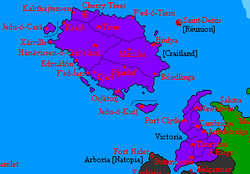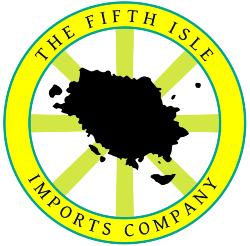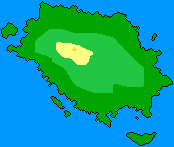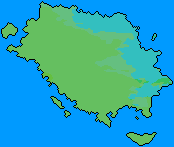Craitland
| Kingdom of Craitland Kingdóm ó Cräiteland (cr) | |||
| |||
| Motto: Vycasio yhn honór | |||
| Anthem: Vycasio yhn Honór | |||

| |||
| Map versions | 9.0.0– | ||
| Capital | Cherry Trees | ||
| Largest city | Osĵätoņ, Hänävissen-ó-Cräiteland | ||
| Official language(s) | Craitish, Common Tongue | ||
| Official religion(s) | None official; Craitish paganism granted cultural protection | ||
| Demonym | Crait | ||
| - Adjective | Craitish | ||
| Government | Constitutional monarchy | ||
| - Monarch | Craitman VIII | ||
| - Prime Minister | Ädel Ämundsdótór | ||
| - Legislature | Parliament of Craitland | ||
| Establishment | 12.XII.1475 AN | ||
| Area | |||
| Population | 22,000,000 | ||
| Currency | Cräite (CRC) | ||
| Calendar | |||
| Time zone(s) | CMT−5 | ||
| Mains electricity | |||
| Driving side | |||
| Track gauge | |||
| National website | Official website | ||
| National forum | Official forum | ||
| National animal | Stag | ||
| National food | Hjoberry | ||
| National drink | Malem | ||
| National tree | Pelle rose | ||
| Abbreviation | CRA, CR | ||
Craitland (Craitish: Cräiteland) is a micronation located on Fifth Isle, off the north-westerly coast of the continent of Apollonia.
Officially the Kingdom of Craitland (Craitish: Kingdóm ó Cräiteland), the nation was founded in 1475 AN and was recognised as a member of the MCS in 1519 AN.
History
Geography
Being situated on Fifth Isle and its surrounding islands, Craitland's mainland borders no other independent nations on Micras. The land is situated in the northern hemisphere of the planet, to the north-west of the continent of Apollonia. Bordering Craitland to the east and north is the Northern Sea, with the island nations of Réunion, and Insulia to the east, to the west the Halberd Strait separating it from Elwynn and Ransenar, and to the south Bruges Bay, which creates a channel to the protectorate of Victoria and the Natopian autonomous territory of Arboria. Further north still is the polar ice cap. Craitland lies approximately between latitudes 52° and 70°N, and longitudes 70° and 90°W.
The majority of Craitland's coastal zones and further inland are low-lying, while highlands dominate the centre of the island with a mountain range to the north-east. The highest point in Craitland, Hänävissen, is situated in this range.
Due to its northerly location, and surrounding by ocean, Craitland's climate is overall a cool and wet one. The Köppen classification of climate considers most of the nation to have a subpolar oceanic climate, while some regions along the nation's eastern coast have been classified under a subarctic climate.
Administrative divisions
For administrative purposes, Craitland's mainland is organised into two tiers of subdivisions; provinces and counties. There are other informal regions within the nation but these are either traditional and serve no modern purpose, or are utilised for non-governmental organisations and services.
Provinces
Provinces are the principal subdivisions in Craitland. While the provinces' primary role is for sub-national legislature, they are also an indication of demarcation of cultural differences between the people of Craitland. There are six in total:
Counties
The provinces are further divided into counties, of which there are 32 in total. Despite having no separate administrative jurisdictions, the counties' chief purpose is for the election of 33 of the 233 members of the Craitish parliament via constituencies. However, these subdivisions are utilised most frequently for postal service designation, local sports organisation and civil registration.
Territories
Craitland currently holds sovereignty over one autonomous territory on Micras, the protectorate of Victoria.
| Flag | Territory | Capital | Location | Craitish sovereignty | Notes |
|---|---|---|---|---|---|
| Victoria | Riego | North-west Apollonia | 1703– | Protectorate; previously an independent kingdom, monarchy shared |
Former territories
Craitland has previously claimed seven further territories at different times in its history.
| Flag | Territory | Capital | Location | Craitish sovereignty | Notes |
|---|---|---|---|---|---|
| Incontinentia | Incontinentia City | South-west Keltia | 1526–1692 | Original territory, autonomy in 1566; subsequently under Alduro-Wechua sovereignty | |
| Lakkvia | Vesüha | Northern Lyrica | 1606–1690 | Original territory; subsequently merged with the Hurmu Trust Territory to reform Hurmu | |
| New South Vietnam | New Saigon | South-east Keltia | 1537–1543 | Protectorate; previously and subsequently under Britannic sovereignty | |
| New Vaduz | New Vaduz | Central Keltia | 1534–1690 | Original territory; subsequently decolonised | |
| Passas | South City | South-west Keltia | 1553–1554 | Protectorate; previously an independent republic, subsequently unclaimed | |
| Talenore | Talenore City | Captive Sea, Keltia | 1634–1646 | Protectorate; previously and subsequently an independent republic | |
| Zandarijn | Hamstadt | South-east Cibola | 1528–1699 | Original territory; subsequently decolonised |
Government and politics
Craitland is a unitary constitutional monarchy. King Craitman VIII is its head of state.
Monarch
The head of state of Craitland is its monarch, by tradition always given the same regnal name, after the nation's founder, and the current monarch is Craitman VIII. The monarch theoretically holds absolute power over Craitland, maintaining the right to overrule parliament under certain conditions, but in practice acts in formality when approving laws and partaking in stately duties.
Government
The executive government of Craitland is composed of members from the party or coalition with majority control over parliament.
Parliament
Craitland's parliament comprises a unicameral legislature of 233 seats. Using the mixed-member proportional representation system of voting, members of parliament are chosen via public polling, with 33 being chosen through the electoral constituencies of the nation's counties and the remaining 200 being divided by proportional representation from the overall popular vote.
Political parties
There are five major political parties in Craitland, based on prior election performance and governmental history. Smaller and single-issue parties are also common, but fail to garner a significant percentage of votes; similarly with independents in their respective seats. The five largest parties and their political alignments are as follows:
Foreign relations
Despite its small population, Craitland has a notably strong presence internationally, in part due to its involvement in a number of Micraswide organisations and projects. Craitland is generally viewed favourably by most other nations' governments and has yet to partake in any armed diplomatic conflicts.
Craitish government policy is to formally recognise any members of the MCS once their application has been accepted, although it is also commonplace for treaties of mutual recognition to be signed between Craitland and others, even if both already officially recognise one another. In recent years, Craitland's closest diplomatic ties have been with Hurmu, Mercury, Senya and Tellia through the Xäiville Convention, while former close relations have been founded with nations through other supranational alliances. Currently, besides recognition treaties, Craitland has also signed agreements with Shireroth, Sankt Ludwigshafen and Natopia pertaining to certain aspects of governance and land sovereignty.
Craitland was formerly a founding member of the Micras Initiative; previously known as the Micro Illuminati. As such, the nation maintained close diplomatic ties with Gralus—and its founding states Novatainia and Toketi—Passas, prior to its ceding of independence, Beaugium, and Batavia. Despite the MI's dormancy in its later years, Craitland remained closely aligned to these nations up until their respective expiry. The MI failed to continue existing upon the death of Toketi in early 2016; leaving Craitland as the only existing member to end the organisation.
As another founding member of the Union of States around the Sovereign Oceans, Craitland subsequently established closed trading and defence ties with Jingdao, the Passasian successor state Passio-Corum, Gerenia and Xang Muang, though Craitish association with the USSO was later reduced.
Military
Craitland's military is a relatively underdeveloped aspect of the nation. Being traditionally pacifistic, Craitland primarily relies on its reputable diplomacy and had no standing armed forces until 1584 AN, when the Craitish Defence Force was established. Craitland's military is strictly reserved for the domestic defence of the nation, and so has yet to be involved in any foreign offences or conflicts.
The Craitish Defence Force is divided into three branches; its army, air force and navy. Craitland's military expenditure is low, even for its population per capita.
Economy

Craitland runs a mixed economy, wherein the majority of public and welfare services are state-run, with free markets dominating the remaining sectors. A number of state-owned enterprises exist, primarily in entertainment, where companies are funded by the Craitish government with the aim of creating financial profit.
The Craitish Cräite is the official currency of Craitland.
Despite limited natural resources, Craitland exports a number of local goods across Micras, primarily to Shireroth across the Halberd Strait. The endemic hjoberry and its derivative alcoholic drink malem are popular exported foodstuffs in the Goldshire and Lichbrook regions of Shireroth. Craitland also has a successful spice industry, with local flavours being exported to a number of nations. Tourism also comprises a sizeable percentage of Craitland's economic income, with many visitors each year being drawn to the nation's culture, scenery and activity range availability.
Demographics
Official estimates put the population of Craitland at around a figure of 22,000,000 as of 1691 AN. Approximately 60% of the nation's population lives in urban areas, with 40% being rural. Craitland's population density is low overall, with particular concentration in coastal areas. Women comprise around 52%, and men 48%, of the population. There is a low birth rate and Craitland's population growth is subsequently also very low.
Ethnic groups
Craitland is vastly homogeneous, with almost 99% of its population being of Caucasian descent. The remaining 1% mainly consists of an immigrant Mongoloid community from Incontinentia, with a mixed Negroid population from varying regions on Micras. Of the sizeable Caucasian populace, an overall 97% are ethnic Craits, while the nation's largest percentages of immigrants are also Caucasians, such as those from Hamland, Hurmu and Passas. The Kej ethnic group native to the north-west of Craitland make-up over 0.5% of the total population.
Language
Craitland's official languages are Craitish and Common Tongue. Craitish is a Germanic language closely related to Common Tongue, originating in Craitland, and is the primary medium of teaching and broadcasting in the nation. Common Tongue's official standing in Craitland is for its usage as a lingua franca in diplomatic relations and international correspondence.
Other minority languages which see usage in Craitland are those which are official in the nation's oldest territories; Batavian from Zandarijn, Germanian from New Vaduz and Incontinentia's native Incontinentian. Kej Craitish is the dialect of Craitish spoken by the Kej peoples of northern Craitland, which has been recognised as a regional language in the province of Metzreäiĵer.
Foreign language study is compulsory in Craitland up until age 16, with many schools offering a selection of differing options, while language study courses in further education are highly popular choices.
Religion
Craitland is an explicitly secular nation. However, Craitish paganism (Craitish: Pägan) holds a status of cultural protection due to its indigenous existence. Craitish paganism is Craitland's largest religious denomination, with around 35% of the population's acknowledged adherence; primarily in the south and east of the nation, while the majority of the population identifies as irreligious. Nazarene has a minority following in more northerly communities; a remnant of Castrum Nazarene's influence on the region, with Umraism being common in immigrant circles. The largest settlements in the nation are also likely to have at least one place of worship for other notable religions, such as Soloralism, Cedrism and Catologism, though their following constitutes a negligible percentage of the nation's population. Despite its growing popularity elsewhere on Micras, Craitism, named for Craitman I, has no recorded followers in Craitland.
Education

Education is compulsory in Craitland up until age 18. Prior to age six, children are reserved places in preschool for the preceding three years before beginning full-time schooling.
Compulsory education is divided into two stages; primary and secondary. Primary education lasts for six years between ages six and twelve, while secondary education lasts between ages twelve and 18, also for six years. There are two tiers of testing in secondary education, with "standard" tests at the age of 16, and "higher" level testing at age 18 in the final year. Up to "standard" level, studying the full range of academic subjects is required, with tests being taken on no fewer than eight courses, with "higher" courses normally being limited to four per student with a minimum of two courses' tests to be taken. While timetables up to "standard" level are full-time, "higher" years' classes are frequently part-time to allow students' exploration of vocational possibilities. Craitland's secondary education tier has previously been lauded for its topic coverage, availability of courses—with many schools focusing on practical subjects such as agriculture and engineering—freedom in students' selection of testing, and its design to help students reach their highest potential.
Following the completion of compulsory education, students have the opportunity to attend university for three- or four-year Bachelor's courses as well as further postgraduate study. All universities in Craitland come under the jurisdiction of the University of Craitland, which is the nation's ultimate degree-awarding authority, while each establishment is run independently, being permitted its own course availability, entrance requirements and funding structures. Tuition costs may be covered directly by the student, via interest-free loans, or through scholarships awarded by the university.
Culture
Craitish culture is inadvertently heavily influenced by that of England, due to its shared early history and developments, such as the Craitish language's relationship with English. Craitland's cultural inspiration is the Faroe Islands, and their culture shares many similarities with aspects of Craitish society. Having a relatively homogeneous population, Craitish culture has only witnessed minimal impact from immigration and is generally uniform across the nation's entirety. Craitish societal culture is based around a shared belief of tolerance and egalitarianism, and local communities are often tightly-knit with concern for their members' welfare.
Arts, entertainment and media
Craitland has a tradition of folklore, primarily related to England's and Scandinavia's, and many of its art forms are influenced by certain stories and legends. Craitish art generally takes inspiration from simplicity, with natural landscapes a common feature among popular painters and wood carving a frequent medium for sculptors.
Music in Craitland is varied in genre, but tends to favour the use of non-electrical instruments and natural vocals. Folk music is highly popular in both popular charts and live performances, with instruments such as the fiddle, smallpipes and fife commonplace, regularly accompanied by rudimentary percussion instruments. Craitland is also a regular participant in the Microvision Song Contest, where it consistently performs well with previous victories to its name.
Broadcast entertainment in Craitland covers a variety of media, with both television and radio prevalent as a means of socialising in private. Craitland's media industry share is split between state-run enterprises and independent corporations, such as television stations CrTV and VVision, respectively. The majority of televised broadcasting is done on a nationwide scale, with certain scheduling reserved for regional programming, while local radio stations outnumber the amount of national channels due to their popularity as community forums.
While newspaper readership remains at a steady constant, especially for broadsheet publications, the internet has become the Craitish public's most popular resource for news updates and reporting.
Cinema is a growing medium in Craitland. The popularity of films from Caputian and Shirerithian studios from around 1645 AN onward spurred an increase in Craitish-made releases, with a number of comedies receiving notably positive reviews from critics.
Sport
Sport plays a major part in Craitish society, and is often considered an integral part of the Craitish culture and identity. Association football is the largest sport in Craitland in terms of registered players, overall expenditure, public match attendance and professional league structure, while ólbescból—a sport of domestic origin—has both more professional and amateur teams affiliated to its organising body. In addition to these, cricket, rugby league, Amorian football and ice hockey are all team sports played to a professional level in Craitland, either with a full domestic league or with franchises playing in Micraswide tournaments. Additionally, Craitish individuals also compete professionally in tennis and motorsport tours across Micras.
Craitland is renowned for its international success in multiple sports, having won world titles in football (FMF World Cup, four times), rugby league (FMRL World Cup, once) and cricket (MCF World T20 Cup, once) with its respective representative national teams.
Football
Association football is the most popular sport in Craitland, and the nation's footballing history and status is well-known internationally. The governing body for the sport in Craitland is the CrFA, which was founded not long after the nation's establishment. The CrFA is responsible for the organisation of the Craitish national team as well as the nation's three professional leagues (League 1, League 2 and League 3) and two cup competitions (the King's Cup and Cities' Cup). The CrFA was a founding member of the FMF, Micras' footballing federation, inaugurated prior to its first ever competition.
Craitland's national team has historically been one of the strongest in the FMF, and is the most successful side in the FMF World Cup, having won four world titles; double that of any other nation's team. The national team holds a number of records, being the only one to have participated in every World Cup finals tournament and being the first to compete in two confederations' competitions; the WMFA's Benacia Cup and EMUFA's EMU Championships, having won both competitions once. Craitland's high-quality domestic setup also means it has had the capacity to successfully host both the EMU Championships and World Cup in its history.
Craitland's top-flight domestic division is League 1, and is contested on an annual basis between ten clubs. Since its inaugural season, the league has expanded from originally containing six clubs and has garnered a reputation as one of the most competitive and high-quality on Micras. Craitish clubs have strong international pedigree, with seven having appeared in a combined fourteen tournament final matches, of which nine have been victorious. League 1 has notable financial support from the Craitish government, coupled with lucrative sponsorship deals and high fan attendance, meaning that many high-profile footballers have transferred to Craitland to ply their trade in the league. The level of Craitish clubs' involvement in the transfer market can be substantiated by over half of the twenty most expensive transfer fees being made by clubs in League 1.
Craitish football culture is seen as an extension of that of its overall society, with a sense of sportsmanship and a welcoming atmosphere common amongst supporters and stadiums. Craitish tolerance is typified by Freddie Gaärsen, arguably the nation's most famous footballer, who was the national team's captain, and is its highest scorer and most-capped player. Gaärsen is openly gay since coming-out whilst still playing and, despite a history of homophobia in the sport, has been lauded for his approach to his sexuality and career by a number of international figureheads.
Ólbescból
Despite football's popularity, ólbescból, also occasionally referred to as orbishball, is the official national sport of Craitland. The sport originated in Craitland and the nation is the only one in which the sport is played to a professional level. The CrÓ is the sport's authority and runs the League A and League B Championships for county teams. The All-Craitland Championship is the sport's premier competition, being competed for by teams representing Craitland's provinces and territories, with the recent additions of two independent national teams.
Folk sports
Craitland's sporting culture has led to the unique phenomenon of "folk sports" being played throughout the nation. Folk sports are games generally played in certain locales, at a completely amateur level, with little to no organisation or official equipment. These sports are common across Craitland, with most settlements having their own respective tournaments or events.
Cuisine
Due to its Scandinavian inspiration, the cuisine of Craitland is similarly influenced by that region's food. Traditional Craitish fare includes fish, meat, root vegetables and cheeses. Because of the nation's climate, with harsh winters affecting farming productivity, food preservation techniques are common, meaning dried meats and pickles are staples in the diet of Craits.
Fifth Isle, on which Craitland is situated, is the endemic home of the hjoberry, which is considered the national fruit. The alcoholic drink malem is produced from fermented hjoberries and is an important part of Craitish society. The south of Craitland also has a tradition of producing ales.
| |||||||||||||||||||||||||||||




